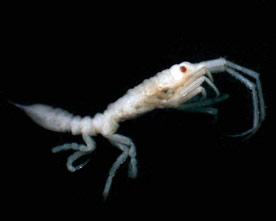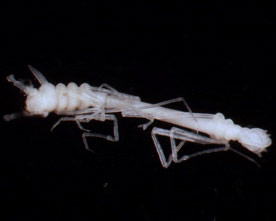Land of Real Mysteries: Antarctica! Strange Fish and Other Creatures
Land of Extremes
Antarctica lies under Australia, which makes it the 'land under the land down under'.
How does one describe the coldest, southern-most continent in the world, that boasts no indigenous human population in it's known history and which, while it is largely snow-covered, is also the location of the earth's largest desert? (A desert here being defined solely in terms of rainfall, or lack thereof, not temperature.)
In some ways, to see this remote, and inhuman terrain, with only a smattering of creatures brave enough or specially suited by nature to sustain an existence there, is to view perhaps, what it would be like to find life on another planet. (Similarities have been drawn, for example, between the moon that circles Jupiter, 'Europa' and Antarctica's sub-glacial lakes.)
In any case, Antarctica was, until relatively late in human exploratory ventures, unknown, or, if known, ignored, lacking as it does, any of those treasures we call 'resources' that could be exploited for gain. (This is a fact which could, in the not too distant future, change dramatically, because, in today's water-hungry world, no less than 70% of our fresh water is actually bound-up in the ice of Antarctica, making it on par with even the most valuable and precious of any known resource for the ongoing needs of ever expanding countries.)

Antarctic Animals
Crustaceans: Hard shell animals that live mostly in the sea. Examples of crustaceans are sea spiders,crabs,krill and shrimp.
Marine Invertebrates: Lacking a backbone such as limpets,snails,octopus,sea stars,sponges,jellyfish and anemones.
Fish: Some examples are; hagfish,robber fish,dragon fish, crocodile fish and cod.
Mammals: Seals, whales and porpoise. Examples are: Weddell seal,Blue Whales and Orca Whales, and Dusky dolphin.
Penguins: Chinstrap,Gentoo,
Adelie, Emporer,King Macaroni and Rockhoppers.
Various other birds: dove, Dominican gull and Georgia pipit.
Ptolemy's Insight
Of particular note is the fact that in 1AD this continent's existence, although not positively known, was 'hypothesized' as existing, by the Greek philosopher Ptolemy, who, with a combination of mathematical precision, and intuitive thought, assumed it's existence simply because the earth's landmasses needed something at the bottom to balance out, in a symmetrical manner, what was then known of the world map.
Quite a feat of hypothetical thinking, but then, he was Ptolemy after all.
What we see most of the time, when we see Antarctica, is the ice sheet which, like a blanket over a bed, covers the actual continent that underlies it. In other words, it is not, as it appears to be, an enormous, floating glacier, but rather is just as solid and earthy, deep down inside, as is our own North America.
Phytoplankton is a Micro Organism With Macro Meaning.
We owe our earth's oxygen-rich atmosphere to a tiny creature that we cannot even see. Phytoplankton is part of what is called collectively 'plankton', which is a combination phyto and zooplankton together. Phyto provides the present day atmosphere with fully one half of it's oxygen, but at one time (during the era of the formation of our earth) there were no plants to make up the other half--that was a job for phytoplankton!
The food chain in Antarctica starts with phytoplankton, which is food for the krill, which in turn is the main food source for some penguins, whales, and 'crabeater' seals, and even sharks. The southern ocean surrounding Antarctica is abundant in dolphin and up to seven types of whales, and phytoplankton is the foundation life form that supports them all. The day that phytoplankton is no longer 'on the menu' the world's entire food chain is in deep trouble.


Weddell Seal
For the Weddell seal of Antarctica the word 'diet' is a dirty word, so important is their fat to their very survival. Most of their average 600kg is a fatty layer, and this in addition to some tightly woven fur, keeps them from freezing in the sub-zero temperatures.
While they love to eat shrimp,krill and crabs, they in turn are eaten by the Orca (killer) whale. The circle of life, one might say.

Orca Whale
Although we call it a whale, the Orca is in fact a member of the dolphin family. It is notorious for it's wolf-like aggressiveness and sports distinctive black and white markings.
A true connoisseur of the buffet approach to dining, the Orca has been known to partake of turtles,blue whales (if small enough), seals,fish and octopi, and sometimes acts in a pack, tracking it's prey with other Orca. A truly impressive wolf of the sea, the Orca is at the top of it's food chain.



Little Men in Black--and White
One need only look at the 'Chinstrap' penguin to see from where it derives it's name.Somewhat of a homebody, the Chinstrap enjoys diving for krill, shrimp and other small crustaceans.
A speedy swimmer, the Chinstrap can exceed 20 miles per hour thanks to his handy flippers, and are seen sledding toboggan-style on land. They keep an eye out for the Leopard seal who preys upon them when he can catch them, and of course their eggs are a favourite orderve of the Sheath-bill and Brown skua birds.
Dragon Fish


Fish of Antarctica
Crocodile Dragon fish are bottom-crawling creatures with exotic looking colouring and features, giving them their appropriate name.They have what can be described as a type of 'anti-freeze' (glycoprotein) in their blood, allowing them to survive in temperatures of extreme cold.
Another fish having both the uniquely exotic look of the Crocodile Dragon and which shares the anti-freeze element, is the Antarctic Cod. This remarkable fish has the ability to lower it's freezing point to -2C and lower it's heart rate to six beats per minute as well, giving it a true value to medical science for which such 'abilities' would be invaluable potential to better understanding autonomic systems in humans.

Antarctica Lexicon
-growler: ships need to look out for these! They are those icebergs which are largely submerged beneath the sea.
-nilas: a flexible ice sheet that will not snap under wave pressure but rather bend with it.
-katabatic: gravity-driven winds of high density.
-nunatak: the name given to where a mountain protudes through the ice.

The Test Tube Continent
It is hard to over-estimate the importance to science, of this remarkable continent.
Many, if not all branches of science, from psychiatry to geology, from biology to space exploration, all find great value in the natural laboratory that Antarctica offers. With it's diversity of life living on the extremes, it offers clear evidence that the parameters of life are far greater and more flexible than we ever suspected, prior to it's discovery.
From scientist like Dr. Eric Christian who uses his balloons to study cosmic rays to Bill Krabill, with NASA, who does important work on ice measurement using laser altimeters, from both the air and on the ground in an ATV. Their goals are broadly the same, to know as much about Antarctica as they can, and then provide their findings to improve our knowledge of the rest of the earth, in particular the timely topic of global warming.
Antarctica in Five Minutes
From the Expedition of Sir Ernest Shakelton
"Men wanted for hazardous journey. Low wages, bitter cold, long hours of complete darkness. Safe return doubtful. Honour and recognition in event of success." [From an advertisement, almost certainly apocryphal, preceding Shackleton's Nimrod expedition.
New Alien Species Discovered in Antarctica: Credit: Wiebke Brokeland
Click thumbnail to view full-size








- Cool Antarctica, pictures of Antarctica, information and travel guide
- ZOOM SCHOOL Antarctica by EnchantedLearning.com
Zoom School is an on-line elementary-school classroom. Subject links include geography, science activities, stories, history, crafts, animals, art, time information, and games, and other subjects that relate to the geographical area. - Discovering Antarctica - teaching and learning resources on Antarctica
Interactive teaching and learning resources on Antarctica developed by RGS-IBG in partnership with BAS and supported by UK FCO. - Virtual Tour: Antarctica
- CIA - The World Factbook -- Antarctica
- Origins: Antarctica: Scientific Journeys from McMurdo to the Pole
Journeys from McMurdo to the Pole. The Exploratorium invites you to follow our crew as they visit the dry valleys and hike up the slopes of volcanic Mt. Erebus. - Antarctica - Wikipedia, the free encyclopedia
- Antarctica - Overview of Antarctica
What you need to know about Antarctica - the coldest, windiest, driest, highest, quietest, most remote, and least understood continent on earth.






















